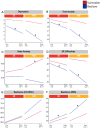Resilient Stress Reactivity Profiles Predict Mental Health Gains from Online Contemplative Training: A Randomized Clinical Trial
- PMID: 38793075
- PMCID: PMC11121773
- DOI: 10.3390/jpm14050493
Resilient Stress Reactivity Profiles Predict Mental Health Gains from Online Contemplative Training: A Randomized Clinical Trial
Abstract
Low-dose app-based contemplative interventions for mental health are increasingly popular, but heterogeneity in intervention responses indicates that a personalized approach is needed. We examined whether different longitudinal resilience-vulnerability trajectories, derived over the course of the COVID-19 pandemic, predicted differences in diverse mental health outcomes after mindfulness and socio-emotional dyadic online interventions. The CovSocial project comprised a longitudinal assessment (phase 1) and an open-label efficacy trial (phase 2). A community sample of 253 participants received 12 min daily app-based socio-emotional dyadic or mindfulness-based interventions, with weekly online coaching for 10 weeks. Before and after the intervention, participants completed validated self-report questionnaires assessing mental health. Stress reactivity profiles were derived from seven repeated assessments during the COVID-19 pandemic (January 2020 to March/April 2021) and were categorized into resilient (more plasticity) or vulnerable (less plasticity) stress recovery profiles. After both interventions, only individuals with resilient stress reactivity profiles showed significant improvements in depression symptomatology, trait anxiety, emotion regulation, and stress recovery. Those with vulnerable profiles did not show significant improvements in any outcome. Limitations of this study include the relatively small sample size and potential biases associated with participant dropout. Brief app-based mental interventions may be more beneficial for those with greater levels of stress resiliency and plasticity in response to stressors. More vulnerable individuals might require more intense and personalized intervention formats.
Keywords: dyads; mental health; mental training; mindfulness; personalization; plasticity; socio-affective; stress reactivity.
Conflict of interest statement
T.S. was honorary co-founder and scientific and curriculum advisor for Humanize from 2021 to summer 2023. Humanize is a start-up that is inspired by T.S.’s mental intervention research as well as her ReConnect Masterclasses and courses focusing on dyadic interventions, including the Affect Dyad, and is releasing modified and extended versions of these dyad intervention programs on a commercial digital platform and app. These additional roles of T.S. have been formally approved by the Max Planck Society. T.S. no longer has an active role or shares in Humanize.
Figures




Similar articles
-
10-Week Trajectories of Candidate Psychological Processes Differentially Predict Mental Health Gains from Online Dyadic versus Mindfulness Interventions: A Randomized Clinical Trial.J Clin Med. 2024 Jun 3;13(11):3295. doi: 10.3390/jcm13113295. J Clin Med. 2024. PMID: 38893006 Free PMC article.
-
Reducing neuroendocrine psychosocial stress response through socio-emotional dyadic but not mindfulness online training.Front Endocrinol (Lausanne). 2024 Jun 24;15:1277929. doi: 10.3389/fendo.2024.1277929. eCollection 2024. Front Endocrinol (Lausanne). 2024. PMID: 38978617 Free PMC article. Clinical Trial.
-
Investigating differential effects of socio-emotional and mindfulness-based online interventions on mental health, resilience and social capacities during the COVID-19 pandemic: The study protocol.PLoS One. 2021 Nov 4;16(11):e0256323. doi: 10.1371/journal.pone.0256323. eCollection 2021. PLoS One. 2021. PMID: 34735441 Free PMC article. Clinical Trial.
-
Effectiveness of online mindfulness interventions on medical students' mental health: a systematic review.BMC Public Health. 2021 Dec 18;21(1):2293. doi: 10.1186/s12889-021-12341-z. BMC Public Health. 2021. PMID: 34920715 Free PMC article.
-
Behavioural modification interventions for medically unexplained symptoms in primary care: systematic reviews and economic evaluation.Health Technol Assess. 2020 Sep;24(46):1-490. doi: 10.3310/hta24460. Health Technol Assess. 2020. PMID: 32975190 Free PMC article.
Cited by
-
10-Week Trajectories of Candidate Psychological Processes Differentially Predict Mental Health Gains from Online Dyadic versus Mindfulness Interventions: A Randomized Clinical Trial.J Clin Med. 2024 Jun 3;13(11):3295. doi: 10.3390/jcm13113295. J Clin Med. 2024. PMID: 38893006 Free PMC article.
-
A neuroscience perspective on the plasticity of the social and relational brain.Ann N Y Acad Sci. 2025 May;1547(1):52-74. doi: 10.1111/nyas.15319. Epub 2025 Apr 3. Ann N Y Acad Sci. 2025. PMID: 40178439 Free PMC article. Review.
References
-
- Wasil A.R., Gillespie S., Patel R., Petre A., Venturo-Conerly K.E., Shingleton R.M., Weisz J.R., DeRubeis R.J. Reassessing evidence-based content in popular smartphone apps for depression and anxiety: Developing and applying user-adjusted analyses. J. Consult. Clin. Psychol. 2020;88:983–993. doi: 10.1037/ccp0000604. - DOI - PubMed
Grants and funding
LinkOut - more resources
Full Text Sources
Medical
Miscellaneous

